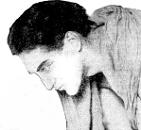A one act, two-hander play dealing with the mysteries of mundane life, Ladder Game is played out on a set comprising three ladders. The unnamed man and woman philosophise about such things as men and woman, umbrellas and ladders, while clambering about the set.
Kester Berwick records that the original stage production (as yet unconfirmed) involved two step ladders, with another, longer, ladder laid across them (thus making an archway). The man sat on top of this, lit by a bright gold-coloured spotlight. Not much else was visible. When the woman joined him on the ladders, with a red umbrella, she was pin-pointed by a red spotlight.
Characters
THE MAN
THE WOMAN
[Author's note.]
About this Play:
Ladder Game was first performed at the Ab-intra Studio, Adelaide, South Australia, about 1934. The setting was merely two step-ladders, with another short, ordinary ladder across them, thus making an archway. The Man sat on top of this, lit by a bright, gold-colored spot-light. Not much else was visible, for the background was entirely of black-hessian curtains. When the Woman joined him on the ladders, and put up her red umbrella, it was pin-pointed by a red spot-light. This gave it a hotly, luminous appearance. The red spot followed them in their "flight" down from the ladders.
Later, on July 31, 1940, the play was broadcasted by the A.B.C. Station 5 C.L., Adelaide. The title had been changed to "Philosophies." In place of a stage-setting, there had to be sound effects, so these were then written into the script. Also a short introduction with music was given by an Announcer. In this instance, the Announcer was myself. Iris Thomas and I then played the two characters. We had also played the two characters in the original Ab-intra performances.
K.B. [Kester Berwick]
Corfu.
14 April 1981


